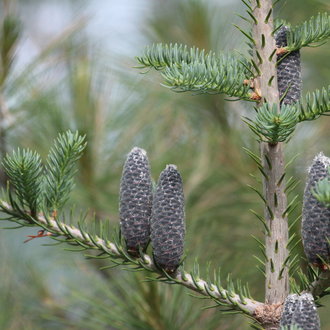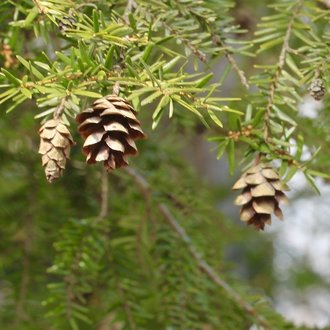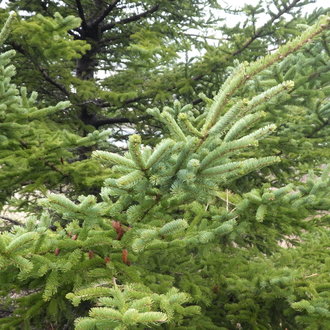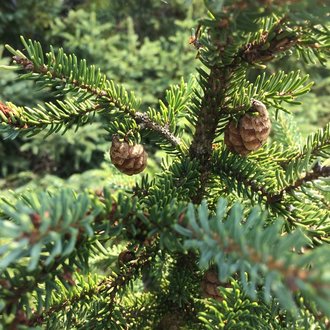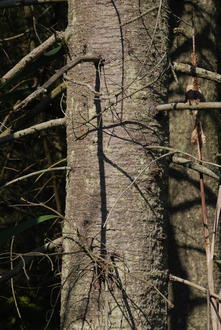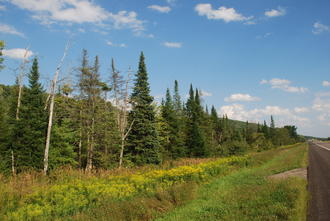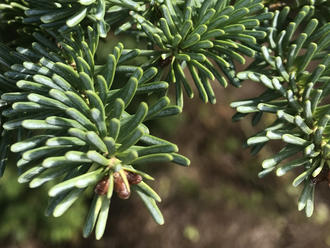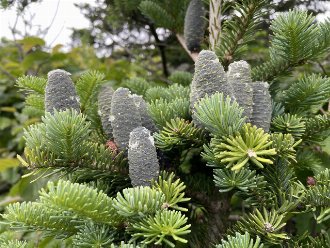Balsam Fir (Abies balsamea (L.) Mill.)
↑Summary
An evergreen conifer native to North America, and a late-successional species found in areas that have not been disturbed recently. The only fir found in the northeast.
↑Range - Expand
| Legend | Color |
| Native | |
| Native or Not Present | |
| Native or Expanded |
This map is based on our research. We have checked its accuracy to Level 3 ecoregions. Although this plant occurs somewhere in each of these regions, it may only occur in a small part of some or all of them.
Following BONAP, we consider the populations in Northeast Ohio to be introduced. The portion of the map in Canada was built using the Silvics manual range map.
↑Description & Identification
Balsam fir is easily identified among conifers by cones, bark, needles, and growth habit. Its cones are upright, contrasting with the hanging cones of most conifers. The bark (photo) is smooth and mostly devoid of features, except for distinctive resin-filled blisters and horizontal rows of lenticels that hint at the appearance of cherry bark. The needles are flat and blunt-tipped. Like other firs, needles attach to twigs at their bases by a green suction-cup-like appendage (photo).
Foliage is markedly different in sun and shade. Needles in shade (photo) are arranged in two flat rows along the twigs, and are usually more green in color and straight. Needles in sun (photo) are distributed more evenly in three dimensions, to give a more full texture around the twig, and are often more bluish in color and curved upwards slightly.
The tree's shape is narrowly conical (photo) and foliage is usually retained the whole way to the base on healthy trees, unless heavily shaded. Branches are held erect and do not droop unless weighted down by snow; angle of branches is usually horizontal lower down on the tree, and weakly ascending higher up. Nearly always grows with a single, large central trunk and only small side-branches.
On harsh sites and past the tree line, grows in a dense, mat-like form.
↑Similar Plants
↑Habitat
Balsam fir is widely adaptable and its occurrence is more limited by climate and successional status than soil conditions. It is found in a wide range of habitats. It can grow in pure stands, mixed coniferous forest, and hardwood-coniferous forests. It occurs on a wide range of soil types and textures, and tolerates a wide range of soil acidity, and even growing on limestone outcroppings; it is absent only from the most acidic sites, where black spruce dominates.
In the north, it grows as low as sea level, but in the south of its range it is only found at higher elevations, where it grows to the tree line. At the southern limit of its range is replaced by the Fraser fir (Abies fraseri). It occurs in a wide range of moisture conditions, from wetland margins to drier conditions such as rocky uplands, but on drier sites it is limited to areas with well-developed soils. In the Midwest it is more limited to moist sites.
A late-successional or climax species, balsam fir is most common in older forests that have not recently experienced fire or other disturbance. Towards the south of its range, however, it can be displaced by shade-tolerant hardwoods such as sugar maple.
Balsam fir is highly susceptible to fire; the USDA's Fire Effects Information System describes it as "the least fire-resistant conifer in the northeastern United States"; it is only found in areas that have not burned recently, and it will be eliminated by fire, usually not returning until fire has been absent from the site for 30-50 years.
↑Life Cycle
Balsam fir is a slow-growing, relatively long-lived coniferous evergreen tree that can eventually grow tall but retains a narrow, conical form.
Seeds mostly germinate between May and July; with sufficient moisture, seedlings can germinate on just about any substrate, but survival is poor on deep hardwood leaf litter.
In moist conditions, seedlings do best on exposed mineral soil. In drought, seedlings do best when growing in rotting wood surrounded by humus, as it retains moisture much longer. Rotting logs and stumps often provide an ideal seedbed, as they are elevated enough to shed leaf litter and can also retain moisture. Seedling establishment in shallow leaf litter (<3 in / 7.5cm) is good, especially relative to other conifers, due to its quick establishment of a deep root system.
Seedlings are highly shade tolerant and can survive for years under a closed canopy.
Seed production usually begins when trees reach about 15 feet of height, which happens around 20 years, although it can be longer in trees suppressed by shade. However, seed production is initially sparse and irregular. Regular seed production typically starts around 30 years of age, with some seed being produced every year, but bumper crops occurring at 2-4 year intervals.
Unlike many conifers, which have cone scales that open to release a seed, then dropping a whole cone, fir cones disintegrate in place on the tree, as individual seeds ripen and are released. Most seeds are dispersed by wind, but small mammals play a supplemental role in dispersing seeds.
Only about half of seeds are viable, and of these, not all germinate. Seeds remain viable for less than one year and there is no seed banking.
Balsam fir can also reproduce vegetatively by layering. Layering is common in swamps and mossy areas, but can also occur on drier sites, under a canopy of jack pine (Pinus banksiana) and eastern white pine (Pinus strobus). Trees at high elevation, especially near the treeline, reproduce primarily by layering.
Trees reach a maximum lifespan of 200 years. Lifespan is longer on moist, well-drained sites, with mortality being higher on poorly-drained sites.
↑Faunal Associations
Various mammals browse the foliage of balsam fir, including snowshoe hare (Lepus americanus), white-tailed deer (Odocoileus virginianus), and especially moose (Alces alces). Mammalian herbivory tends to slow growth but is rarely fatal to the tree, except in areas where white-tailed deer are overabundant.
Balsam fir provides shelter for songbirds, small mammals, and the larger mammals listed above. It is host to 114 species of moths and butterfly larvae such as the imperial moth (Eacles imperialis) and white-marked tussock moth (Orgyia leucostigma).
Balsam fir, like spruces, is also eaten by the spruce budworm, which tends to have cyclical outbreaks causing death of trees over large areas. Stands of balsam fir are most likely to be killed on poorly-drained soils under either very wet or very dry conditions, which stress trees, if the stands are at least 50 years old, if balsam fir and other host species reach above other trees in the canopy, and if the susceptible species are growing densely together.
In addition to the spruce budworm, this species also supports the hemlock looper and blackheaded budworm. The introduced balsam wooly adelgid also eats this species, and can kill trees in 3 years. However, balsam fir is not as vulnerable as the more southerly fraser fir (Abies fraseri).
↑Uses
The wood is exceptionally lightweight, but not very durable. It is used mainly as pulpwood for paper production, and lumber for construction of lightweight frames and in other applications where low weight is more important than strength or durability, such as paneling and crates.
Balsam fir is commonly grown in tree farms for use as Christmas trees, wreathes and other holiday decorations.
↑Related Plants
Numerous other firs occur in North America, including two introduced species and several native ones, but few have overlapping ranges.
The closest relative of this species is Fraser fir (Abies fraseri) which occurs in disjunct populations to the south. That species was historically considered a variety of balsam fir. These species probably originated from a single species that used to have a continuous distribution when the climate was cooler. As the climate warmed, the southern populations became isolated and the species diverged in characteristics. Trees in Virginia and West Virginia have been described as potential hybrids between these two species, or they could represent relics of more continuous clinal variation between the ancestral populations.
Some authors have labeled these populations Abies balsamea var. phanerolepis, also known as bracted balsam fir or ‘Canaan Fir’, the latter of which has been cultivated for Christmas tree farming and can tolerate more adverse site conditions.
Also closely related is subalpine fir (Abies lasiocarpa), which occurs in the mountains of northwestern North America. Where these species ranges overlap in the Canadian Rockies, they naturally hybridize.
↑Links & External Resources
• Balsam Fir | The Wood Database (About This Site)
• Balsam Fir | Fire Effects Information System (FEIS) (About This Site)
• Abies balsamea (Balsam Fir) | USDA PLANTS Database (About This Site)
• Abies balsamea | Go Botany (About This Site)
• Abies balsamea (Balsam Fir) | Missouri Botanical Garden Plant Finder (About This Site)
• Balsam Fir | Virginia Tech Dendrology Factsheets (About This Site)
• Balsam Fir | Silvics of North America (About This Site)
• Abies balsamea | Biota of North America Project (BONAP) (About This Site)
• Abies balsamea | NatureServe Explorer (About This Site)
• Abies balsamea | Flora of North America (About This Site)
• Balsam Fir | Maryland Biodiversity Project (About This Site)
• Abies balsamea (L.) Miller (Balsam Fir, Northern Balsam) | Digital Atlas of the Virginia Flora (About This Site)



